Flying lioats
IN the 1930s, flying boats became the largest, most comfortable passenger planes in the world. The spacious planes had hulls shaped like boats and floats under their wings. They could land and take off on the sea, as well as lakes and rivers.
In a time when aircraft engines were still unreliable, people thought flying boats were a safer wray to travel over the ocean.
Pan American Airlines called its flying boats clippers, alter the speedy sailing ships. They carried passengers to exotic destinations, such as the Far East and South America, at a time when few airports existed.
Flying boats were luxury cralt designed to compete with ocean liners. The biggest was Pan Am s Boeing 314 Clipper. A 106-foot-long-giant, it carried passengers at 174 miles an hour to Hong Kong or other cites in unequaled comfort. Yet as airports were built all over the world, flying boats were replaced by land aircralt.


![]()

 When a flying boat landed on water, it tied up di a mooring buoy or simply dropped its own anchor, like a ship.
When a flying boat landed on water, it tied up di a mooring buoy or simply dropped its own anchor, like a ship.



* Traveling the World
The cover of a 1930s Pan American timetable, in the Museum collection, shows routes spanning much of the globe. These routes opened the world to air travelers.
У China Clipper
The Martin M -130, the"China Clipper," rests at a mooring station off Manila after her first transpacific flight on November 29,1935.The streamlined plane flew from San Francisco to Manila in 59 hours.
 ERY different from the flimsy biplanes of World War I, the fighter aircraft of World War II were tough, fast, and efficient. Aircraft had now become a primary means of waging war. Two nations, Germany and Japan, set out to dominate the world. In 1939, Nazi Germany began invading European countries. The German air force was called the Luftwaffe, or “air weapon.” Its Messerschmitt Bt 109 was a swift, fearsome fighter. More than 33,000 were produced.
ERY different from the flimsy biplanes of World War I, the fighter aircraft of World War II were tough, fast, and efficient. Aircraft had now become a primary means of waging war. Two nations, Germany and Japan, set out to dominate the world. In 1939, Nazi Germany began invading European countries. The German air force was called the Luftwaffe, or “air weapon.” Its Messerschmitt Bt 109 was a swift, fearsome fighter. More than 33,000 were produced.
German fighters and bombers terrorized Europe. Allied nations, including the United States, produced thousands of aircraft to light Germany and Japan. Fight eggs escorted bombers deep into enemy territory and battled in dogfights. Pilot skill was paramount. Spurred by war, aircraft advanced rapidly. Sleek new fighters flew at over 400 miles an hour and went 2,000 miles without refueling. By war’s end, the iirst
Combat Pilot

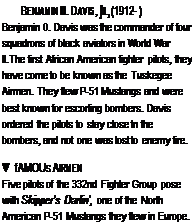
![]()
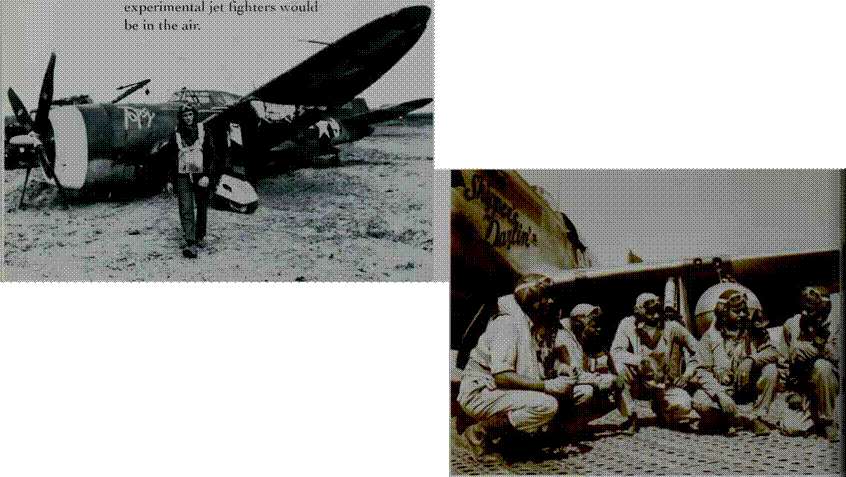
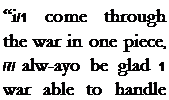 Wounded and dazed, pilot Quentin C. Aanenson poses with his P-47 Thunderbolt fighter plane, Topsy. Aanenson had just crash-landed on his base after being hit by "flak,"or antiaircraft fire, in a mission over Germany.
Wounded and dazed, pilot Quentin C. Aanenson poses with his P-47 Thunderbolt fighter plane, Topsy. Aanenson had just crash-landed on his base after being hit by "flak,"or antiaircraft fire, in a mission over Germany.

![]()
* Supermarine Spitfire
Britain’s most famous fighter, the Spitfire was fast and nimble and could outmarieuver the German Bf 109.This Spitfire in the Museum is a high-altitude version of the fighter, and could fly over
40,0 feet.


¥ Curtiss Р-і»о Warhawk
Lieutenant Donald Lopez stands with his P-40 Warhawk in 1943. Mow Deputy Director of the National Air and Space Museum, Lopez became an ace flying with the Fourteenth Air Force. They battled the Japanese in China.

North American P-31 Mustang
A pilot smiles inside his P-51 D Mustang. This U. S. fighter could fly at 440 miles an hour. It was fitted with a drop tank so it could fly extra miles to go deep inside Germany. Swastikas on the plane’s side represent German planes shot down.
► Messerschmitt Bf 109
Germany’s Messerschmitt Bf 109 was the main opponent of the P-51 Mustang and the British Spitfire. With a top speed of 385 miles an hour, it could swiftly climb, dive, and turn in dogfights.
|
 ? ScRAMBLt!
? ScRAMBLt!
British fighter pilots run to their Hawker Hurricane fighters to take off during the Battle of Britain. Though not as agile as the Spitfire, the sturdy Hurricane easily shot down large numbers of slower, low-flying German bombers.
|
1 L ч |
– |
|
|
mk |
^ 4 |
|
‘Never… wao oo much owed by о о many to oo few. All heart,* go out to the fighter piloto, whooe brilliant actio no we, tee with out own eyeo day after day… ” British Prime Minister Winston Churchill |
|
|
|
|
|
|
|
|
|
|
|
![]()

THE United States produced thousands of bombers during World War II. Among the most famous was the Boeing B-17. Called the Flying Fortress, this plane lived up to its name. It could carry over 17,000 pounds of bombs, and was armed with 12 machine guns for defense against enemy fighters. Later U. S. bombers included the Boeing B-24 Liberator and the enormous B-29 Superfortress. Many bombers were destroyed by enemy fighters and antiaircraft guns early in the war. The use of fighter escorts helped bombers complete their missions. Later bombers, such as the B-29, could fly to high altitudes beyond the reach of most enemy fire.
 |
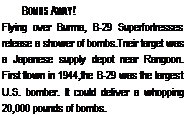 |
 |
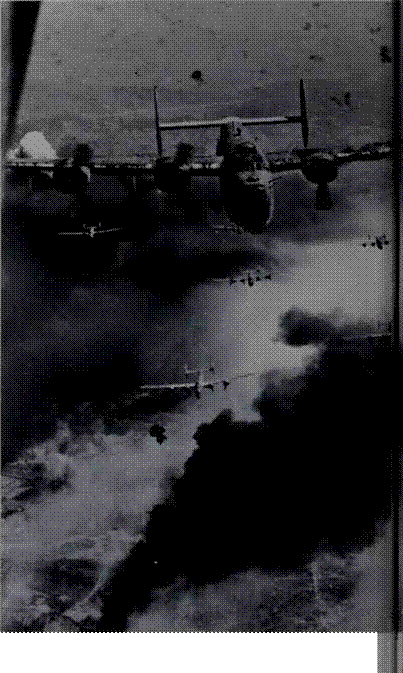 Bombers attacked in huge fleets of up to a thousand to knock out enemy luel bases, arms supplies, and transportation lines. Never before had aircraft been used to destroy on such a large scale.
Bombers attacked in huge fleets of up to a thousand to knock out enemy luel bases, arms supplies, and transportation lines. Never before had aircraft been used to destroy on such a large scale.
![]()



► Flak Bait
The nose section of Flak Bvit, a Martin B-26 Marauder bomber, is now in the National Air and Space Museum. Ihis plane flew 200 missions over Europe, more than any other Allied bomber. Over 1,000 patches cover holes made by antiaircraft tire, or"flak."
Inside Flak Bait
This interior view shows the radio and navigation station of Flak Bait. Visible through the door is the cockpit instrument panel. It was shattered by a German Bf 109 Messerschmitt shell in 1943.The wounded pilot managed to safely land the plane.
► The WASPs
Women pilots train to fly B-17 bombers at a flight school during the war. Known as the Women’s Airforce Service Pilots (WASPs), they transported military aircraft to war zones. They flew everything from fighters to heavy bombers. Over 30 were killed in service.
4 B-17 Waist Gunner
Inside a B-17 Flying Fortress, gunner Robert Taylor fires a 50-caliber machine gun to ward off attacking German fighters. He wears warm clothing and a metal-lined "flak apron" to protect against shell fire.
AFTER Japanese warplanes bombed the U. S. naval base at Pearl Harbor in 1941, the United States entered the war. During the next years, much of the war took place at sea. From 1941 to 1945, the L United States and Japan battled in the Pacific.
■ Their most powerful weapons were aircraft
carriers. Floating airfields, the huge ships known as "flattops” were 820 Feet long and carried up to 100 warplanes. Fighters and bombers took off and landed on their flat decks. The carriers allowed great mobility of air attack.
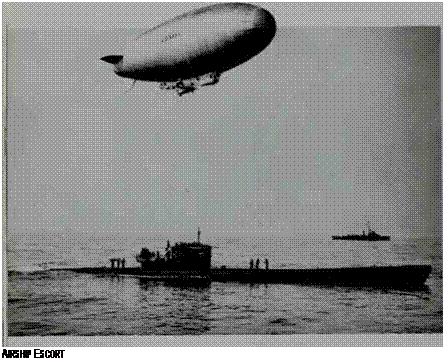 |
 |
 In 1942, Japan launched an attack on Midway Island with four carriers. Navy dive bombers From three U. S. carriers surprised and attacked die Japanese fleet. They sank all four Japanese carriers. With the ships, Japan lost 250 planes and their most veteran pilots. This was a crippling blow that marked the turning point against Japan in the Pacific.
In 1942, Japan launched an attack on Midway Island with four carriers. Navy dive bombers From three U. S. carriers surprised and attacked die Japanese fleet. They sank all four Japanese carriers. With the ships, Japan lost 250 planes and their most veteran pilots. This was a crippling blow that marked the turning point against Japan in the Pacific.
![]()


Kamikaze
The Cherry Blossom, a Japanese Kugisho MXY7 Ohka kamikaze bomber, is today part of the Museum collection. Japanese kamikaze pilots flew these planes, filled with bombs, deliberately into Allied ships. They believed that suicide in such attacks was an honorable death.
Bullseye!
U. S. Navy Douglas Dauntless dive bombers bomb the Japanese aircraft carrier Akogl in this painting. The bombers sank this and three other Japanese carriers near Midway Island in 1942. Most of Japan’s most skilled pilots and their planes, plus 3,000 sailors, v/ere lost.
Cleared to Go
A signal officer aboard a U. S. carrier waves the takeoff flag for a Grumman Hellcat fighter. Carrier takeoffs and landings took great pilot skill. A net across the deck helped damaged planes returning from battle to skid safely to a stop.










